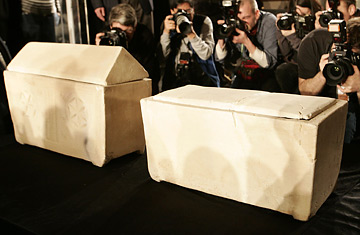
Producers of Discovery Channel's The Lost Tomb of Jesus unveil two ossuaries that experts believe may have belonged to Jesus and Mary Magdalene in New York on February 26, 2007.
At a certain point, as I sat in a grand room at the New York Public Library and heard Titanic director James Cameron explain why the bone box in front of him might have held Jesus' remains, I began thinking fondly of Rev. Raymond Brown, one of the 20th century's great historical-Jesus experts. Reading him was no joyride. His footnotes seemed to have footnotes. But that was the point. His scholarship was such that even when one of his books called the virgin birth "unresolved," it got a go-ahead from his Roman Catholic Church.
That won't happen with The Jesus Family Tomb by Simcha Jacobovici and Charles Pellegrino, a sidecar to Jacobovici's Cameron-produced Discovery Channel documentary. Jacobovici claims that 10 bone boxes from an ancient Jerusalem-area crypt bear such a suggestive combination of names (JESUS SON OF JOSEPH, MARY, JOSE) that it must be the holy family's tomb. His statistician has set the odds at 600 to 1 in favor. He thinks one inscription, MARIAMENE E MARA, denotes Mary Magdalene, and another, JUDAH SON OF JESUS, her son by the Saviour.
Thus the book challenges the bodily Resurrection and Assumption of Christ and adds a very holy matrimony. Jacobovici seems surprised at the shelling he has taken on TV and in blogs. "It's what sociologists call a mobilization of bias," he says. "Certain questions cannot even be asked, and certain answers are not conceivable." Personally, I find the book too dependent on stretched scholarship and conjecture to make its title case. Yet if my vision is clouded, I don't think it's by MOB. More like OTMSBBS: one-too-many-speculative-Bible-books syndrome.
The issue is less titles like The Jesus Papers--by Michael Baigent, a nonacademic who claims Jesus survived the Crucifixion but who cannot produce solid proof--than the plunge into alternative biblical narrative by recognized scholars. The Jesus Dynasty by James Tabor of the University of North Carolina at Charlotte, who also aided Jacobovici, enmeshes a plausible story of early church strife in speculative material suggesting that Jesus had a human father and hoped for an earthly kingship. Professors and best-selling authors Elaine Pagels and Bart Ehrman both have books out claiming to derive new insights from the rediscovered Gnostic Gospel of Judas--itself a best seller. Their logic is solid, but their topic is daring.
Why? Ehrman, 51, says the dynamic of the academy has changed. "The generation that trained us would spend many years honing their discipline until they felt they could write their seminal work, maybe in their 50s," he says. "This generation is different. You publish as quickly as possible, create a sensation and get known [academically] that way." (Ehrman himself waited 10 years.)
Then there is what Publishers Weekly senior religion editor Lynn Garrett calls the Da Vinci Code effect. "Speculative histories were out there before Dan Brown wrote," says Garrett. "But they didn't make the best-seller lists and their authors didn't go on The Daily Show." Or receive a million-dollar paycheck, as was rumored in a recent case.
But Garrett cautions that "it's not simply following the dollar. Writing popularly, I think, they feel freer." Scholars are not working more speculatively because Dan Brown made money. His success allows them to write profitably from their adventurous hearts. Mark Tauber, vice president of HarperSanFrancisco, which publishes many of them (HSF did Family Tomb), notes that these academics came of age during the translation of the Nag Hammadi "library" and the Dead Sea Scrolls, troves that opened a window to unorthodox faith during and after Jesus' life that the Bible and church fathers only hinted at or condemned. The authors can now transmit that vision to a Da Vinci--primed public. Says HSF editorial director Michael Maudlin: "Maybe we have enough evidence to say that our understanding of what happened back then was too simple. Dan Brown didn't invent it, but he made it sexy." Says Tauber: "I think it's wonderful."
Well, perhaps so. But like many wonderful (and not so wonderful) things, it's moving forward to a herky, sometimes unintelligible beat. The kind that makes one nostalgic for the deliberate, footnoted revolutionism of Father Brown.
